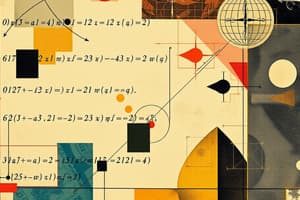Podcast
Questions and Answers
What describes a linear function?
What describes a linear function?
- An arc on the graph
- A straight line (correct)
- A cubic shape
- An exponential curve
What is a quadratic function characterized by?
What is a quadratic function characterized by?
It has x squared in it.
What type of graph does a quadratic function create?
What type of graph does a quadratic function create?
A parabola
What is the definition of an exponential function?
What is the definition of an exponential function?
What does the term 'cubic' refer to?
What does the term 'cubic' refer to?
What does 4th degree refer to?
What does 4th degree refer to?
What is absolute value?
What is absolute value?
What do you base the name of a function off of?
What do you base the name of a function off of?
A negative number can have a square root.
A negative number can have a square root.
What value will any horizontal line always have?
What value will any horizontal line always have?
What is an asymptote?
What is an asymptote?
What is a parent graph?
What is a parent graph?
What is the linear parent graph?
What is the linear parent graph?
What do you get when you solve f(x) = 4x + 5?
What do you get when you solve f(x) = 4x + 5?
Dividing by a fraction is the same as which operation?
Dividing by a fraction is the same as which operation?
What is the result if the exponent is 0?
What is the result if the exponent is 0?
What does the symbol ≤ mean?
What does the symbol ≤ mean?
What does the symbol ≥ signify?
What does the symbol ≥ signify?
What is the vertex of a parabola?
What is the vertex of a parabola?
What is the slope of a line with a positive slope?
What is the slope of a line with a positive slope?
What characterizes a line with an undefined slope?
What characterizes a line with an undefined slope?
What does an open upward parabola resemble?
What does an open upward parabola resemble?
What does an open downward parabola resemble?
What does an open downward parabola resemble?
A number is a perfect square if...
A number is a perfect square if...
What are two ways to find a point if you have an equation?
What are two ways to find a point if you have an equation?
What steps do you take to find the intersection point where a parabola and line intersect?
What steps do you take to find the intersection point where a parabola and line intersect?
What categories can all lines be put into?
What categories can all lines be put into?
What categories can all parabolas be grouped into?
What categories can all parabolas be grouped into?
What type of slope does a horizontal line have?
What type of slope does a horizontal line have?
Flashcards are hidden until you start studying
Study Notes
Linear Functions
- Linear equations graph as straight lines.
- The highest exponent in a linear function is 1.
Quadratic Functions
- Quadratic functions include a variable with an exponent of 2.
- Graphs of quadratic equations form a parabola, which can open upward or downward.
Exponential Functions
- Exponential functions have variables in their exponents.
Cubic and Higher Degree Functions
- Cubic functions contain variables raised to the power of 3.
- 4th degree functions involve variables raised to the power of 4.
Absolute Value
- Absolute value represents the distance from zero, disregarding negative signs.
Function Naming
- The name of a function is based on the highest exponent present.
Characteristics of Lines
- Horizontal lines maintain a constant Y value.
- The slope of a horizontal line is 0; vertical lines have an undefined slope.
Asymptotes
- Asymptotes are lines that approach a curve without ever touching it.
Irrational Numbers
- Irrational numbers have non-repeating, non-terminating decimal expansions, e.g., Euler's number (E=2.71828...).
Function Notation
- f(3) indicates substituting X with 3 to find the corresponding Y value.
- The equation Y = f(X) shows the relationship between input (X) and output (Y).
Parent Graphs
- Parent graphs represent the simplest form of functions.
- Examples include linear parent graph (Y = X) and quadratic parent graph (Y = X²).
Algebra Operations
- Dividing by a fraction equals multiplying by its reciprocal.
- An exponent of 0 results in a value of 1.
Vertex of a Parabola
- The vertex is the highest or lowest point of a parabola.
Finding Intersection Points
- To determine intersections between a line and a parabola, use a graphing calculator's intersect function.
Classifying Lines and Parabolas
- Lines are categorized as positive slope, negative slope, 0 slope, or undefined slope.
- Parabolas fall into two categories: open upward or open downward.
Perfect Squares
- A number is a perfect square if its square root is a positive integer.
Studying That Suits You
Use AI to generate personalized quizzes and flashcards to suit your learning preferences.




